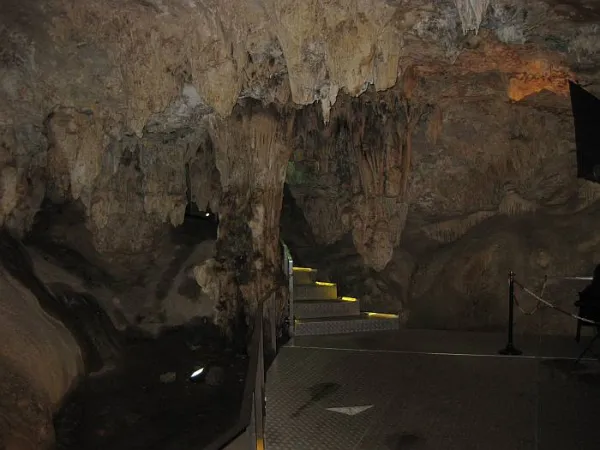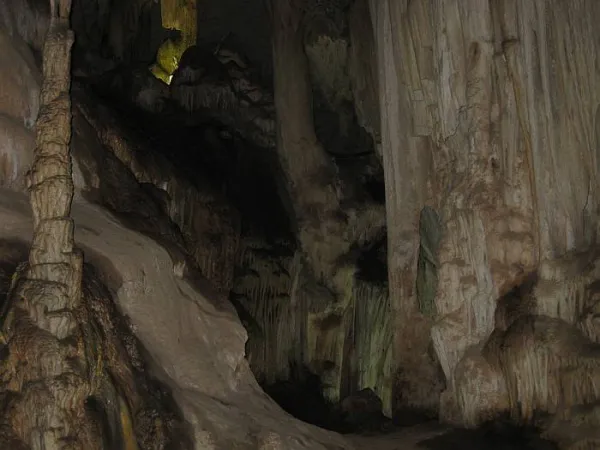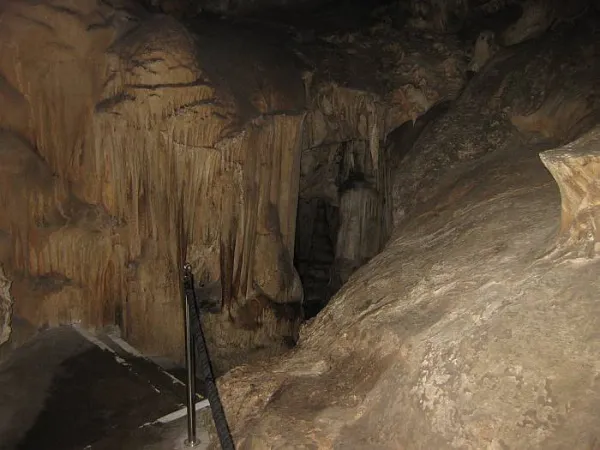A trip to Andalucía would not be complete without a visit to the Nerja Caves, one of Spain’s most popular and spectacular historical sites.
The magnificent Nerja Caves – Cuevas de Nerja – are a series of huge caverns stretching for almost five kilometres and home to the world’s largest stalagmite, a 32 metre high column measuring 13 metres by 7 metres at its base. There are three Galleries – Show Gallery, Upper Gallery and New Gallery – with each gallery containing a number of Halls. The Upper Gallery and New Gallery contain many of the prehistoric cave paintings, but tourist access to these areas is limited to special groups.
The Discovery
On January 12th 1959, five local lads from the village of Maro decided to go hunting for bats and headed for a pothole known locally as ‘La Mina’ where they spent the night watching a great number of these creatures exiting through the hole in the rocks.
Francisco Navas Montesinos, Manuel Muñoz Zorrilla, Miguel Muñoz Zorrilla, José Luis Barbero de Miguel, José Torres Cárdenas
The boys decided to return the next day, taking with them some tools to dislodge a couple of stalagtites in the entrance. Once inside, they found themselves able to descend to a huge cavern where they discovered a number of skeletons next to some ceramic pottery.
Excited by their find, they went back to tell their family, friends and teachers but it wasn’t until the cave was visited by a medical expert and a photographer that the true extent of their discovery became apparent.
A sculpture commemorating the discovery of the Caves stands on the Balcón de Europa. The sculpture, which was placed on the Balcón de Europa in April 2010, is the work of Francisco Martín. The statue of King Alfonso XII on the Balcón de Europa is also the work of Francisco Martín.
The first photographs of the caves were published in the Málaga newspaper ‘Sur’ about 100 days after their discovery and after first being called ‘Cueva de las Maravillas’, they then became ‘Cueva de Nerja’. The Nerja Caves were officially inaugurated on June 12th 1960 and opened to the public.
A sculpture commemorating the discovery of the Caves is located near the entrance to the Nerja Caves


There are a number of options for your visit to the Nerja Caves including several special guided tours, such as The Secrets of the Caves, The Discovery Tour and a Night Tour.
About the Nerja Caves
The magnificent Nerja Caves – Cuevas de Nerja – are a series of huge caverns stretching for almost five kilometres and feature amongst the top tourist attractions in Spain. There are two natural entrances to the caves and one man-made, the latter having been made in 1960 to allow easy access for visitors.
History
The caves are the formation of karstic cavities, their origin dating back millions of years. During the Triassic period, large quantities of calcareous mud settled on the bottom of the ancient Mediterranean sea, later transforming into the calcareous-dolomite marble which at present surround the caves.
During the Upper Miocene period, about 5 million years ago, drifts between the tectonic layers of Africa and Europe resulted in the creation of the Beticas mountains, including the Sierra Tejeda and Almijara. The abundant rain of the last 5 million years (Upper Miocene and Lower Pleistocene) infiltrated the fissures of marbles, stimulating its further dissolution.
Huge cavities, in which the underground waters circulated, were thus formed. Later, due to mountain slides in the region, the subterranean waters were forced into the lower layers and, as a consequence, the caves started to refill with carbonate deposits, stalactites and stalagmites.
In the last 800,000 years (Middle Pleistocene and Holocene) the impressive stalactites and stalagmites have formed following further settling of calcite.
Early Inhabitants
Skeletal remains found in the Nerja Caves indicate that they were inhabited from about 25,000 BC up until the Bronze Age, first being used as a seasonal dwelling place and then later becoming a year round residence for the human population in the area. When not in use by humans, the caves would be occupied by hyenas. Cave paintings, found on the walls, date back to the Paleolithic and Post-Paleolithic periods and show a culture based upon hunting.
By 4,500 BC, the domestication of animals was part of the local culture and the caves were being used for farming purposes and pottery production, and by 3,800 BC, advanced styles of pottery and textiles were being produced in the area and parts of the caves began to be used as a burial chamber.
Inside the Caves
The caves are divided into Galleries and each Gallery is made up of a number of Halls.
Galleries
There are three galleries, the Show Gallery, the Upper Gallery and the New Gallery. Access to the Upper and New Galleries is restricted.
Show Gallery
Sala de Vestibulo – Entrance Hall
Includes some archaeological exhibits.
Sala de la Mina – Mine Hall
Excavation area, not normally open to the public.
Sala de la Torca – Hall of the Sink
Excavation area, not normally open to the public.
Sala de Belén – Hall of the Nativity
Contains columns of calcite and there is a skeleton on display in a glass case.
Sala del Colmillo – Hall of the Tusk
Sala de la Cascada o Ballet – Hall of the Waterfall or Ballet
Sala de los Fantasmas – Hall of the Phantoms
Named after an unusual speleothem (secondary mineral deposit producing various types of stalagmites, stalagtites etc).
Sala del Cataclismo – Hall of the Cataclysm
Home to a huge central column which, at 32 metres high, is the tallest in the world.
Rincón del Órgano – Organ Corner
The fluted columns in this hall can be struck to produce different musical notes and it is thought that some of the columns were intentionally altered by early prehistoric inhabitants to produce different notes.
Upper Gallery
Columnas de Hércules – Columns of Hercules
Sala de la Inmensidad – Hall of Immensity
New Gallery
Sala de la Lanza – Hall of the Lance
Sala de la Montaña – Hall of the Mountain
Area
Total Surface Area: 35.484 m2
Total Volume: 64,379 m3
Getting There
The Nerja Caves are easily accessible by car, bus or even on foot and there is ample parking in and around the site.
By Car
Driving to the Nerja Caves is fairly straightforward and will take about ten minutes at a leisurely pace. Leave Nerja on the old N-340 coastal road in the direction of Maro. You will pass the Nerja Club Hotel (on your right), Capistrano Village (on your left), Fuente del Baden (on your left) and the old Sugar Factory (worth a visit, despite being derelict) and arrive at a roundabout.
Follow the sign to Maro. On your left you will see the old, picturesque Eagle Aquaduct, still in use and scheduled for renovation, before arriving at another roundabout. Take the final exit and about 100 metres up the hill is the entrance to the Nerja Caves.
By Bus
The journey time is between 10 and 15 minutes and the current full bus company timetables, routes, travelling times and fares an be found here: Alsa.
On Foot
Although it is 5.2 kilometres from the Balcón de Europa, generally considered to be the ‘centre’ of Nerja, walking to the Nerja Caves is neither out of the question nor does it pose any great difficulties. In fact, during the San Isidro procession each May 15th, thousands walk this route. The easiest route is to follow the N-340 coastal road, much as you would if you were going by car or bus. It is an uphill journey, although only the last 100 metres could be classified as ‘steep’.
Should you choose to walk, a couple of tips if you are doing so during the summer when temperatures are generally well into the 30’s:
1. Wear a hat, apply plenty of sunscreen and avoid bare skin on the back otherwise you may well suffer.
2. Carry a small bottle of water. You will almost always see locals carrying bottles of water during the summer, a precaution against dehydration.
3. Try and avoid the hottest time of day, normally between about 14:00 and 16:00.
Nerja Caves Train
A regular Tourist Train (Wally Trolley/Noddy Train) service runs between Nerja and the Nerja Caves, stopping in Maro along the way. You can also purchase an ‘all in’ ticket which includes entry to both the Nerja Caves and the Nerja Museum. Check here for details: Caves Train






























